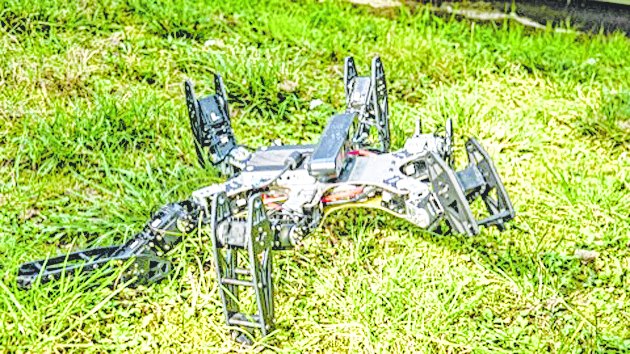
New Delhi, May 28: Scientists have built prototypes of what could be the world's first robots designed to continue performing assigned tasks even when severely damaged with a broken arm or missing legs, working around such "injuries" in less than two minutes.
An Indian computer scientist was part of a team of four researchers in France and the US who have developed a new algorithm --- a set of procedures to solve a problem --- that enables robots to quickly adapt to injuries like animals and humans do.
Their feat, described in the journal Nature today, could be a major advance in efforts to overcome the fragility of robots that is among factors the scientists say are hampering the widespread adoption of robots in complex environments outside assembly lines and factories.
"When you hurt your ankle, you quickly find a way to walk, even with a limp, despite the injury, perhaps by exerting more pressure on the other leg or foot. Our algorithm works similarly," Danesh Tarapore, a team member who is now at the University of York in Britain, told The Telegraph.
The researchers say their algorithm is intended to spawn a new generation of robots that could quickly recover from any damage to their electronic or mechanical components that they might experience during activities in hostile or unknown environments.
The key to the new technology is a so-called Intelligent Trial and Error algorithm that allows the robot to recognise the damage it has suffered and use whatever power and other abilities it has to continue with its assigned tasks.
According to the researchers, their robots do not repair themselves --- they work despite the damage.
Although fault-tolerant systems are commonplace across electronics, scientists say they are primarily based on redundancies and back-up systems. In the new strategy, the robot learns how to cope with whatever damage comes its way.
"The robot does not perform any diagnosis, it only finds a way to continue its mission in spite of the damage," Jean-Baptiste Mouret, the team leader and an associate researcher in computer science at Inria, an academic institution in France, told this newspaper.
"The difference is the same as between finding a way to limp with an extremely painful knee but not knowing exactly what is wrong, and visiting a doctor to get an MRI and learn precisely what happened to your knee," Mouret said.
A diagnosis would require more skill and equipment than simply finding a limp that minimises pain. This is why the algorithm the researchers have invented allows the robot to recover fast ---- in less than two minutes.
In their experiments, the researchers tested the algorithm on robots with a variety of "injuries" --- a hexapod robot continued to work with two of its legs cut off while a robotic arm continued to function with two of eight motors failing and its arm joints broken.
The researchers say such damage-tolerant robots can have multiple applications.
"If we send robots to find survivors after earthquakes or to put out forest fires or to shut down a nuclear power plant in a crisis, we need them to keep working if they become damaged in unpredictable and hostile environments," Mouret said.
"Even robot assistants at home that can help the elderly or the sick need to keep performing their tasks even if some of their parts fail."
The other two team members were Antoine Cully, a PhD candidate at the University Pierre and Marie Curie in France, and Jeff Clune, an assistant professor of computer science at the University of Wyoming.
Scientists say the biggest challenge to building such robots is to programme them in such a manner that they quickly find ways to improvise after damage.
"It is not possible to programme the best response to each and every injury because there is simply no way to list all possible ones," said Christoph Adami, a biologist at the Michigan State University who was not associated with the work.
The approach that Mouret and his colleagues have taken involves creating a repertoire of possible movements that the robot searches to pick the best response to adopt after damage.
"We use principles of Darwinian evolution to help the robot discover the best way to perform tasks despite damage," said Tarapore, who studied at the Indian Institute of Technology, Bombay, before doing a PhD in Switzerland and joining Mouret's laboratory as a post-doctoral researcher.











